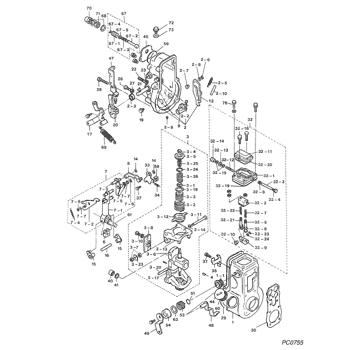Rating:
Information shaft, lever suppo Denso
Include in ##:
09130-00441
as SHAFT, LEVER SUPPO
Cross reference number
Part num
Firm num
Firm
Name
09156-30050
ME702173
SHAFT, LEVER SUPPO
0915630050
22358-1410
HINO
SHAFT, LEVER SUPPO
0915630050
22358-1410A
HINO
SHAFT, LEVER SUPPO
0915630050
22558-78031
TOYOTA
SHAFT, LEVER SUPPO
0915630050
ME702173
MITSUBISHI
SHAFT, LEVER SUPPO
0915630050
S2235-81410-A
HINO
SHAFT, LEVER SUPPO
Information:
The electrical system is a combination of two separate electric circuits: the charging circuit and starting circuit. Each circuit is dependent on some of the same components. The battery (batteries), disconnect switch, circuit breaker, ammeter, cables and wires from the battery are common in each of the circuits.
The disconnect switch must be ON to allow the electrical system to function. Some charging circuit components will be damaged if the engine is operated with the disconnect switch OFF.
The charging circuit is in operation when the diesel engine is operating. The electricity producing (charging) unit is an alternator. An alternator regulator in the circuit senses the state of charge in the battery and regulates the alternator output to keep the battery fully charged.The starting circuit operates only when the disconnect switch is ON and the start switch is actuated.The direct electric diesel engine starting circuit includes a glow plug for each diesel engine cylinder. Glow plugs are small heating elements in the precombustion chambers which promote fuel ignition when the engine is started in low temperatures.The lighting and charging circuits are both connected on the same side of the ammeter while the starting circuit connects to the other side of the ammeter. This alternator is a three phase self-rectifying charging unit.The alternator has four main components: end frame assembly (brush end), rotor assembly, stator and shell assembly, and end frame assembly (drive end).A separate regulator senses the charge condition of the battery as well as electrical system power demand and controls the alternator output accordingly by limiting the field current.
Never operate the alternator without the battery in the circuit. Making or breaking an alternator connection with a heavy load on the circuit will sometimes result in regulator damage.
The starting motor is a device used to rotate the flywheel of an engine fast enough to start the engine. Alternator Charging Circuit
(Negative Ground System Illustrated)
24 VOLT DIRECT ELECTRIC STARTING MOTORThe starting motor used with direct electric start incorporates a solenoid. The action of the solenoid engages the pinion with the ring gear on the engine flywheel, when the solenoid is energized. The pinion always engages before the electric contacts in the solenoid closes the circuit between the battery and the starting motor. An over-running clutch protects the starting motor from being overspeeded. Releasing the start-switch disengages the pinion from the ring gear on the flywheel.A solenoid is a magnetic switch that utilizes low current to close a high current circuit. The solenoid has an electromagnet with a movable core. There are contacts on the end of the core. The contacts are held open by a spring that pushes the core away from the magnetic center of the coil. Low current will energize the coil and form a magnetic field. The magnetic field draws the core to the center of the coil and the contacts close.
The disconnect switch must be ON to allow the electrical system to function. Some charging circuit components will be damaged if the engine is operated with the disconnect switch OFF.
The charging circuit is in operation when the diesel engine is operating. The electricity producing (charging) unit is an alternator. An alternator regulator in the circuit senses the state of charge in the battery and regulates the alternator output to keep the battery fully charged.The starting circuit operates only when the disconnect switch is ON and the start switch is actuated.The direct electric diesel engine starting circuit includes a glow plug for each diesel engine cylinder. Glow plugs are small heating elements in the precombustion chambers which promote fuel ignition when the engine is started in low temperatures.The lighting and charging circuits are both connected on the same side of the ammeter while the starting circuit connects to the other side of the ammeter. This alternator is a three phase self-rectifying charging unit.The alternator has four main components: end frame assembly (brush end), rotor assembly, stator and shell assembly, and end frame assembly (drive end).A separate regulator senses the charge condition of the battery as well as electrical system power demand and controls the alternator output accordingly by limiting the field current.
Never operate the alternator without the battery in the circuit. Making or breaking an alternator connection with a heavy load on the circuit will sometimes result in regulator damage.
The starting motor is a device used to rotate the flywheel of an engine fast enough to start the engine. Alternator Charging Circuit
(Negative Ground System Illustrated)
24 VOLT DIRECT ELECTRIC STARTING MOTORThe starting motor used with direct electric start incorporates a solenoid. The action of the solenoid engages the pinion with the ring gear on the engine flywheel, when the solenoid is energized. The pinion always engages before the electric contacts in the solenoid closes the circuit between the battery and the starting motor. An over-running clutch protects the starting motor from being overspeeded. Releasing the start-switch disengages the pinion from the ring gear on the flywheel.A solenoid is a magnetic switch that utilizes low current to close a high current circuit. The solenoid has an electromagnet with a movable core. There are contacts on the end of the core. The contacts are held open by a spring that pushes the core away from the magnetic center of the coil. Low current will energize the coil and form a magnetic field. The magnetic field draws the core to the center of the coil and the contacts close.
